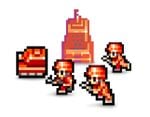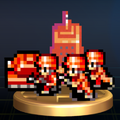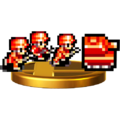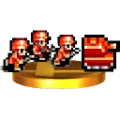| Welcome to SmashWiki! Log in or create an account and join the community, and don't forget to read this first! |
| Notices |
|---|
| The Skill parameter has been removed from Smasher infoboxes, and in its place are the new "Best historical ranking" and "Best tournament result" parameters. SmashWiki needs help adding these new parameters to Smasher infoboxes, refer to the guidelines here for what should be included in these new parameters. |
| When adding results to Smasher pages, include each tournament's entrant number in addition to the player's placement, and use the {{Trn}} template with the matching game specified. Please also fix old results on Smasher pages that do not abide to this standard. Refer to our Smasher article guidelines to see how results tables should be formatted. |
| Check out our project page for ongoing projects that SmashWiki needs help with. |
Nintendo Wars (universe): Difference between revisions
m (→Assist Trophy) |
No edit summary |
||
| Line 16: | Line 16: | ||
|interwikipage = Advance Wars (series) | |interwikipage = Advance Wars (series) | ||
}} | }} | ||
The '''''Nintendo Wars'' universe''' ({{ja|ファミコンウォーズ|Famikon Wōzu}}, ''Famicom Wars'') is a series of military-themed turn-based strategy games developed by [[Intelligent Systems]] and published by [[Nintendo]]. | The '''''Nintendo Wars'' universe''' ({{ja|ファミコンウォーズ|Famikon Wōzu}}, ''Famicom Wars'') is a series of military-themed turn-based strategy games developed by [[Intelligent Systems]] and published by [[Nintendo]]. | ||
==Franchise Description== | |||
The series was born out of a desire by Intelligent systems to branch out of their auxillary roots and develop their own games. While ''Soccer'' was technically the first game developed solely by the team, ''{{s|warswiki|Famicom Wars}}'', the first game in the series, was the first original property the team would create. The game on the Famicom exclusively in Japan on August 12, 1988. The game is a military themed turn-based strategy game with an emphasis on realistic simulation. The goal is to guide units around the map and defeat the enemy team without being defeated yourself. there are several classes with varying degrees of health and power, with some possessing unique abilities to aid the battle. The game was a success for the company and helped pave the way for more games to be greenlit, particularly its sister series, {{uv|Fire Emblem}}, in 1990. | |||
A sequel for Game Boy was immediately put into production. Titled ''{{s|warswiki|Game Boy Wars}}'' and released on May 21, 1991, the game is mostly similar to the Famicom original, except on on a portable level. An enhanced version, titled ''Game Boy Wars Turbo'' released on June 24, 1997 and includes smarter enemy units, more content and Super Game Boy support. While Intelligent systems was hard at work on their next project, Hudson Soft took over the series in the mean time. Their first title was ''{{s|warswiki|Game Boy Wars 2}}'', a direct sequel to the first Game Boy outing. released on November 20, 1998, the game features further improve enemy units, overhauled UI elements, and cross-compatibility with Game Boy Color. On May 1 of that year, Intelligent Systems returned with ''{{s|warswiki|Super Famicom Wars}}''. Naturally released on Super Famicom, both in stores and as a downloadable title to writable Nintendo Power cartridges, the game introduced multiple factions and a "fog of war" mechanic that hides enemy units. Hudson Soft returned again for their final entry in the series, ''{{s|warswiki|Game Boy Wars 3}}'' for Game Boy Color on August 30, 2001. The game was greatly different from other games in the series, having deeper resource mechanics and a beginner mode for those new to the series. | |||
One month later on September 10, 2001, ''{{iw|warswiki|Advance Wars|game}}'' released in North America on Game Boy Advance. This marks the first time the series officially released outside of Japan. The game later released in PAL regions in early 2002. The game now features a less realistic "pop design" that would be the signature artsyle for the series going forward. The game recieved a large amount of polish by the designers, particularly in how maps were balanced. Units and maps were continuously tweaked until they were basically forced to stop and ship the game. This game is frequently regarded as the best in the series, with excellent sales across the world. A direct sequel to this game, ''{{s|warswiki|Advance Wars 2: Black Hole Rising}}'', also released on Game Boy Advance in North America on June 24, 2003 and in Pal regions later that year. There was no major changes added to the game other then cosmetic tweaks and a new campaign. While the consenus became what was there is still excellent, the game felt samey and the series needed to shake things up. The two ''Advance Wars'' games were not initially released in Japan, only making it over on November 25, 2004 as a collection titled ''Game Boy Wars Advance 1+2''. | |||
this sub-series continued on with ''{{s|warswiki|Advance Wars 2: Dual Strike}}'' for the [[Nintendo DS]], which released in Japan as ''Famicom Wars DS'' on June 23, 2005 and around the world later in the year. Due to the vastly different features of the DS, the game recieved many unique changes from previous titles. This included unique map design that two screen can provide, more intuitive UI that a touch screen can provide, new game modes and up to eight player multiplayer through wireless play. This game was the breath of fresh air that fans wanted, with reviews that rivaled ''Advance Wars'' in terms of praise for presentation and innovation to the series. | |||
Kuju was then assigned to make a spinoff duology while Intelligent Systems made a new project. The first was ''{{s|warswiki|Batallion Wars}}'', which released on September 19, 2005 for [[GameCube]], making it the first console ''Wars'' game since ''Super Famicom Wars''. Originally titled ''Advance Wars: Under Fire'', the name was changed so players do not expect a typical entry in the series. The game is a departure from the series in that it incorporates more real-time elements and is a mix of the classic formula and a third-person shooter. The second and final game was ''{{s|warswiki|Batallion Wars 2}}'', which released for [[Wii]] on October 29, 2007. The game is similar to its predecessor, but included more units and combat variety, as well as being the first in the series to contain online multiplayer. | |||
Intelligent Systems returned with ''{{s|warswiki|Advance Wars: Days of Ruin}}'' for DS on January 21, 2008. Despite the name, the game is a standalone title with no connection to any prior entry, this time set in a gritty post-apocalyptic setting. The series also introduced terrain options and a map editor that allows player to create and post their custom maps online. The series then went into a hiatus with no original entries since. The franchise has recently been revived on the [[Nintendo Switch]] sith ''{{iw|warswiki|Advance Wars 1+2: Re-Boot Camp}}'', being developed in collaboration with [[WayForward Technologies]]. The game currently has a 2022 release date. | |||
==In ''[[Super Smash Bros. Brawl]]''== | ==In ''[[Super Smash Bros. Brawl]]''== | ||
Revision as of 18:09, November 1, 2021
| Nintendo Wars (universe) | |
|---|---|

| |
| Developer(s) | Intelligent Systems Kuju Entertainment WayForward Technologies |
| Publisher(s) | Nintendo |
| Genre(s) | Turn-based strategy |
| Console/platform of origin | Famicom |
| First installment | Famicom Wars (1988) |
| Latest installment | Advance Wars: Days of Ruin (2008) |
| Article on Advance Wars Wiki | Nintendo Wars (universe) |
The Nintendo Wars universe (ファミコンウォーズ, Famicom Wars) is a series of military-themed turn-based strategy games developed by Intelligent Systems and published by Nintendo.
Franchise Description
The series was born out of a desire by Intelligent systems to branch out of their auxillary roots and develop their own games. While Soccer was technically the first game developed solely by the team, Famicom Wars, the first game in the series, was the first original property the team would create. The game on the Famicom exclusively in Japan on August 12, 1988. The game is a military themed turn-based strategy game with an emphasis on realistic simulation. The goal is to guide units around the map and defeat the enemy team without being defeated yourself. there are several classes with varying degrees of health and power, with some possessing unique abilities to aid the battle. The game was a success for the company and helped pave the way for more games to be greenlit, particularly its sister series, Fire Emblem, in 1990.
A sequel for Game Boy was immediately put into production. Titled Game Boy Wars and released on May 21, 1991, the game is mostly similar to the Famicom original, except on on a portable level. An enhanced version, titled Game Boy Wars Turbo released on June 24, 1997 and includes smarter enemy units, more content and Super Game Boy support. While Intelligent systems was hard at work on their next project, Hudson Soft took over the series in the mean time. Their first title was Game Boy Wars 2, a direct sequel to the first Game Boy outing. released on November 20, 1998, the game features further improve enemy units, overhauled UI elements, and cross-compatibility with Game Boy Color. On May 1 of that year, Intelligent Systems returned with Super Famicom Wars. Naturally released on Super Famicom, both in stores and as a downloadable title to writable Nintendo Power cartridges, the game introduced multiple factions and a "fog of war" mechanic that hides enemy units. Hudson Soft returned again for their final entry in the series, Game Boy Wars 3 for Game Boy Color on August 30, 2001. The game was greatly different from other games in the series, having deeper resource mechanics and a beginner mode for those new to the series.
One month later on September 10, 2001, Advance Wars released in North America on Game Boy Advance. This marks the first time the series officially released outside of Japan. The game later released in PAL regions in early 2002. The game now features a less realistic "pop design" that would be the signature artsyle for the series going forward. The game recieved a large amount of polish by the designers, particularly in how maps were balanced. Units and maps were continuously tweaked until they were basically forced to stop and ship the game. This game is frequently regarded as the best in the series, with excellent sales across the world. A direct sequel to this game, Advance Wars 2: Black Hole Rising, also released on Game Boy Advance in North America on June 24, 2003 and in Pal regions later that year. There was no major changes added to the game other then cosmetic tweaks and a new campaign. While the consenus became what was there is still excellent, the game felt samey and the series needed to shake things up. The two Advance Wars games were not initially released in Japan, only making it over on November 25, 2004 as a collection titled Game Boy Wars Advance 1+2.
this sub-series continued on with Advance Wars 2: Dual Strike for the Nintendo DS, which released in Japan as Famicom Wars DS on June 23, 2005 and around the world later in the year. Due to the vastly different features of the DS, the game recieved many unique changes from previous titles. This included unique map design that two screen can provide, more intuitive UI that a touch screen can provide, new game modes and up to eight player multiplayer through wireless play. This game was the breath of fresh air that fans wanted, with reviews that rivaled Advance Wars in terms of praise for presentation and innovation to the series.
Kuju was then assigned to make a spinoff duology while Intelligent Systems made a new project. The first was Batallion Wars, which released on September 19, 2005 for GameCube, making it the first console Wars game since Super Famicom Wars. Originally titled Advance Wars: Under Fire, the name was changed so players do not expect a typical entry in the series. The game is a departure from the series in that it incorporates more real-time elements and is a mix of the classic formula and a third-person shooter. The second and final game was Batallion Wars 2, which released for Wii on October 29, 2007. The game is similar to its predecessor, but included more units and combat variety, as well as being the first in the series to contain online multiplayer.
Intelligent Systems returned with Advance Wars: Days of Ruin for DS on January 21, 2008. Despite the name, the game is a standalone title with no connection to any prior entry, this time set in a gritty post-apocalyptic setting. The series also introduced terrain options and a map editor that allows player to create and post their custom maps online. The series then went into a hiatus with no original entries since. The franchise has recently been revived on the Nintendo Switch sith Advance Wars 1+2: Re-Boot Camp, being developed in collaboration with WayForward Technologies. The game currently has a 2022 release date.
In Super Smash Bros. Brawl
Assist Trophy
Infantry and Tanks: They appear as a single Assist Trophy in Brawl, using their original sprites from the Advance Wars games. Soldiers and tanks will drop from the sky, causing minimal damage, and they will then travel left or right. The Infantry will fire their guns, while the tanks will blast from their turrets, both inflicting fair knockback. Infantry is unlocked as an Assist Trophy after 300 Vs. Matches have been played.
Trophy
Infantry & Tanks
- Units first introduced in Famicom Wars, where they fight battles against enemy forces. Infantry are the least expensive to deploy of all units. They're not too strong, but they move well and can capture property. There are two tank types: tank A, which is expensive but has good mobility and firepower, and tank B, which is cheaper but can change battles with sheer numbers.
: Famicom Wars (Japan Only)
: Advance Wars
Stickers
| Name | Game | Effect | Characters |
|---|---|---|---|
| Max | Advance Wars | ||
| Sami | Advance Wars | ||
| Andy | Advance Wars | ||
| Jake | Advance Wars: Dual Strike | ||
| Hawke | Advance Wars: Dual Strike | ||
| Rachel | Advance Wars: Dual Strike |
 Max (Advance Wars) |
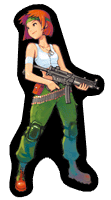 Sami (Advance Wars) |
 Andy (Advance Wars) |
 Jake (Advance Wars DS) |
 Hawke (Advance Wars DS) |
 Rachel (Advance Wars DS) |
In Super Smash Bros. 4
Assist Trophy
Infantry and Tanks: Return as an Assist Trophy in Super Smash Bros. 4 and are functionally the same as in Brawl.
Trophy
Infantry & Tanks
Two units from the Advance Wars series, infantry are best for capturing bases and tanks for fighting the enemy. If summoned, these two form up on the player who activated them. Don't underestimate them just 'cause they're pixels—the infantry's gun and tank's cannon are formidable.
Two units from Famicom wars. In this game, they'll appear in pixel form on both sides of the character that called them up. The infantry then fire their guns while the tanks use cannon fire and drive into people. Cute as they are, don't underestimate them or you'll find yourself in a world of hurt!
: Famicom Wars (Japan)
In Super Smash Bros. Ultimate
The Infantry & Tanks do not reprise their roles as an Assist Trophy, but do appear as a spirit, in addition to Andy, Eagle, and Olaf from the Advance Wars series.
Spirits
Primary spirits
| No. | Image | Name | Type | Class | Slots | Base |
Max |
Base |
Max |
Base |
Max |
Ability | Series |
|---|---|---|---|---|---|---|---|---|---|---|---|---|---|
| 1,135 | Andy | ★★ | 3 | 1435 | 5744 | 696 | 2786 | 739 | 2958 | No Effect | Advance Wars Series | ||
| 1,136 | Eagle | ★ | 1 | 1006 | 5034 | 584 | 2920 | 422 | 2114 | No Effect | Advance Wars Series | ||
| 1,137 | Olaf | ★ | 1 | 953 | 4768 | 386 | 1931 | 567 | 2837 | No Effect | Advance Wars Series |
Support spirit
| No. | Image | Name | Class | Cost | Ability | Series |
|---|---|---|---|---|---|---|
| 1,134 | Tank & Infantry | ★★ | 2 | Super Scope Equipped | Famicom Wars Series |
Games with elements appearing in the Super Smash Bros. series
Famicom Wars
- Assist Trophy
 Infantry and Tanks originate from this game.
Infantry and Tanks originate from this game.
- Trophy
- Spirits
Super Famicom Wars
Advance Wars
- Assist Trophy
 The design for Infantry and Tanks comes from this game.
The design for Infantry and Tanks comes from this game.
- Stickers
- Spirits
Advance Wars 2: Black Hole Rising
Game Boy Wars Advance 1+2
Advance Wars: Dual Strike
